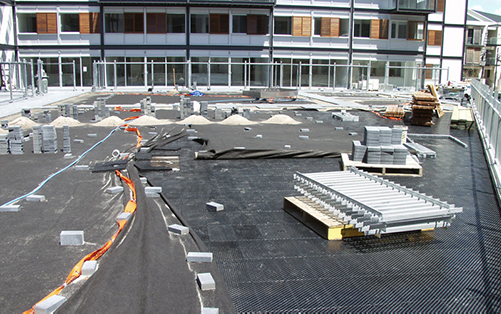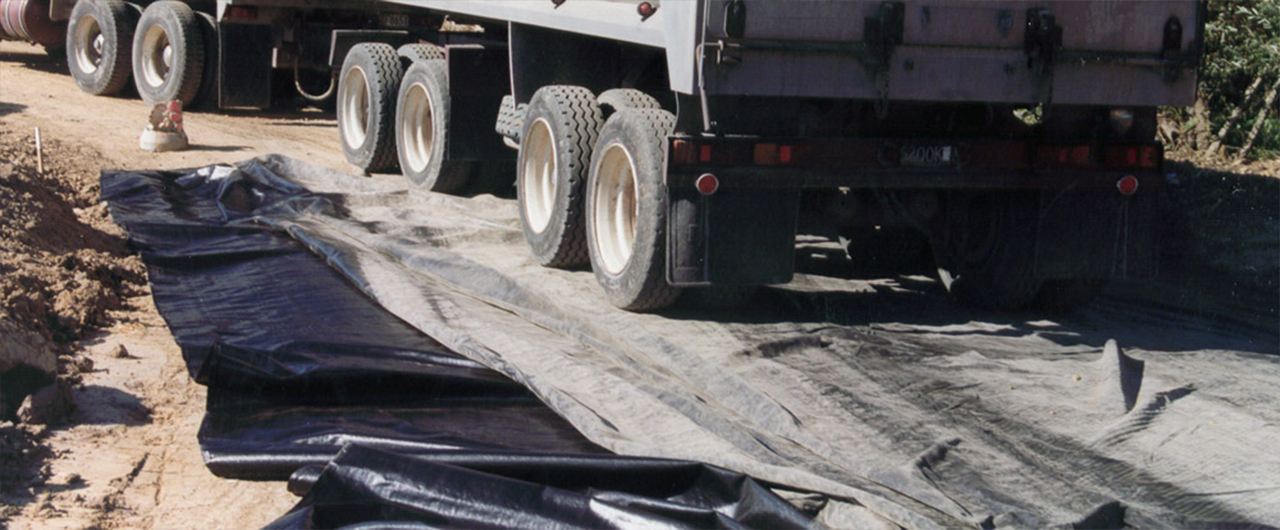Geotextiles
Geotextiles are a geosynthetic material used for applications civil including drainage, reinforcement of soils, separation of gravel and soil, environmental applications including de-watering of contaminated liquids, geomembrane protection.
The types of geotextiles are woven and nonwoven. Drainage applications would typically use a nonwoven due to their ability to filter without clogging and unpaved roads normally use a woven geotextile.
Applications and Applicable Grades
Erosion Control (covered by soil or rock):
Nonwoven Strength Class B, C, D or E; Woven 110gsm, 160gsm, 220gsm (if uncovered by soil Noweed Weedmatting may be suitable for long term or Jute Matting for short term).
Drainage (trench drain, edge drain, counterfort drain, planter box, rainwater harvesting):
Nonwoven Strength Class A, B, C.
Note: Woven geotextile is not recommended for these applications.
Roadway Separation:
Nonwoven Strength Class A, B, C, D, E; Woven 160gsm, 220gsm. For saturated ground with a CBR of < 3 it is recommended to use nonwoven Class C, D, E.
Roadway Stabilisation:
Nonwoven Strength Class B, C, D; Woven 160gsm, 220gsm, High Strength.
Horse Arena:
Nonwoven Strength Class C; Woven 160gsm.
Geomembrane Liner Protection:
Nonwoven Strength Class C, D, E.
Landfill Leachate Collection:
Nonwoven Strength Class B, C.
Landfill Drainage Systems:
Nonwoven Strength Class C



Nonwoven Geotextile
Nonwoven polypropylene (PP) geotextiles are made from needle punched polypropylene staple fibre. These fibers are cut, opened, laid onto a web, needled, inspected, tested and rolled. The production technique produces a product described typically as “a nonwoven needle punched geotextile”.
Roadway stabilisation/ separation
Roads and highways are built using geotextile to prevent aggregate from mixing with the subgrade and to strengthen the soil, reducing pot holes
Drainage
Syntex nonwoven geotextiles are ideal for drainage applications. Unlike woven geotextiles (with the exception of monofilament drainage fabrics), polypropylene nonwovens resist clogging. Nonwovens are placed in direct contact with the earth where drainage stone, perforated drain coil, etc may be placed. The nonwoven filters soil and waste while allowing water and leachate to pass.
Geomembrane Protection
Syntex heavy weight nonwoven geotextiles will cushion and protect geomembranes from puncture caused by aggregate and basecourse. Gas Venting: Heavy weight nonwoven geotextiles are used for collection and lateral transmission of liquids and gases that may build up under a geomembrane used in a capping of waste facility.
Hard amour underlay
Syntex nonwoven geotextiles are recommended to help relieve hydrostatic pressure beneath hard armour and prevent soils from migrating to the surface providing an effective erosion control method.
Mudstop Woven Geotextile
Woven geotextiles are manufactured by extruding polypropylene film and then slitting the film into individual yarns which are then woven to form the geotextile.
Mudstop woven geotextiles provide a stable base for unpaved roads. The fabric prevents subsoil mixing with aggregate which, without geotextile, will quickly require repair. Not only will the soil migrate to the surface but also deep ruts will occur causing greater repair costs.
Mudstop woven geotextiles also provide stabilisation over soft ground. Where access roads become boggy due to vehicles and poor weather, a woven geotextile can provide the needed foundation by spreading the load across a wide area.
Mudstop is a permeable, woven polypropylene geotextile designed for applications where soil stabilisation and separation are major functions and strength is not critical.
When used and installed correctly the fabric may be used as follows:
- Separation of aggregates in parking, pavements, and roads
- Low cost temporary or permanent roading for construction vehicles in problem traffic areas
- Under aggregate to prevent loss of fill into subsoil and allow top cover to remain firm
- Filter lining for erosion control and stop banks